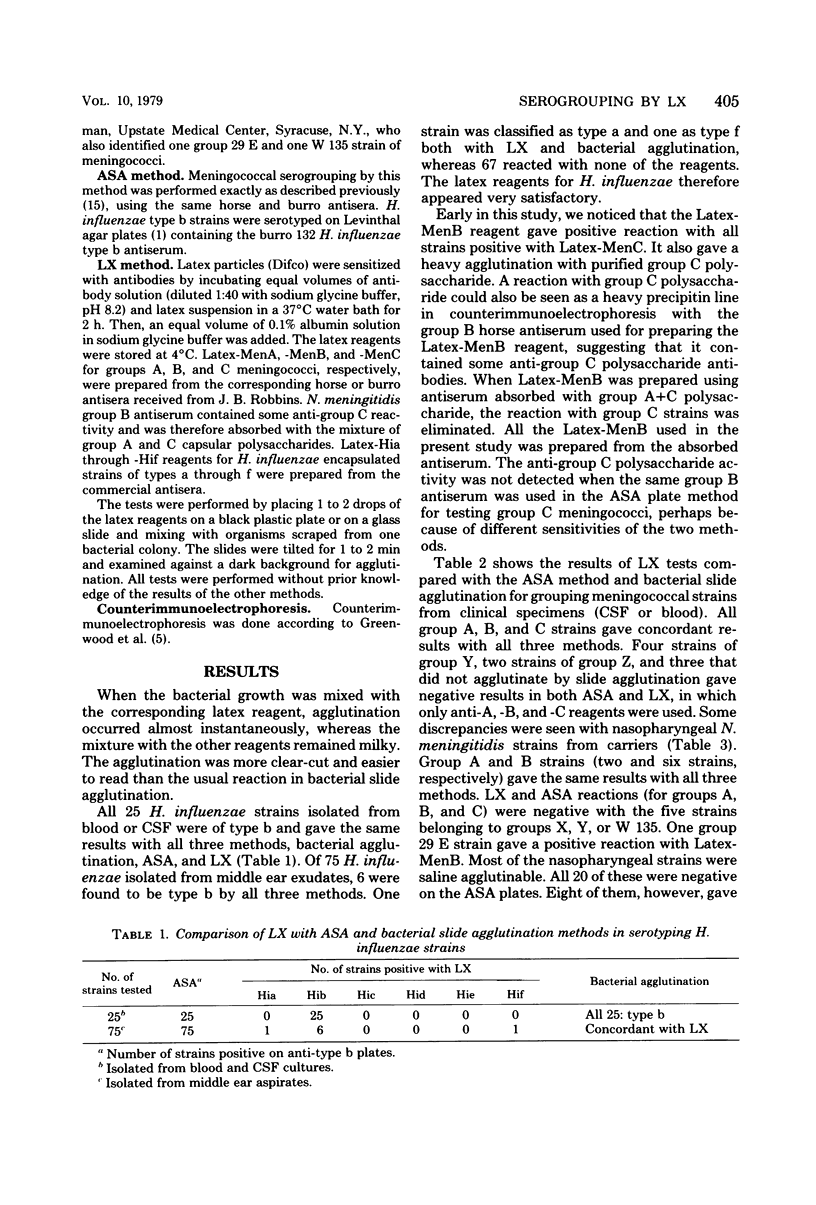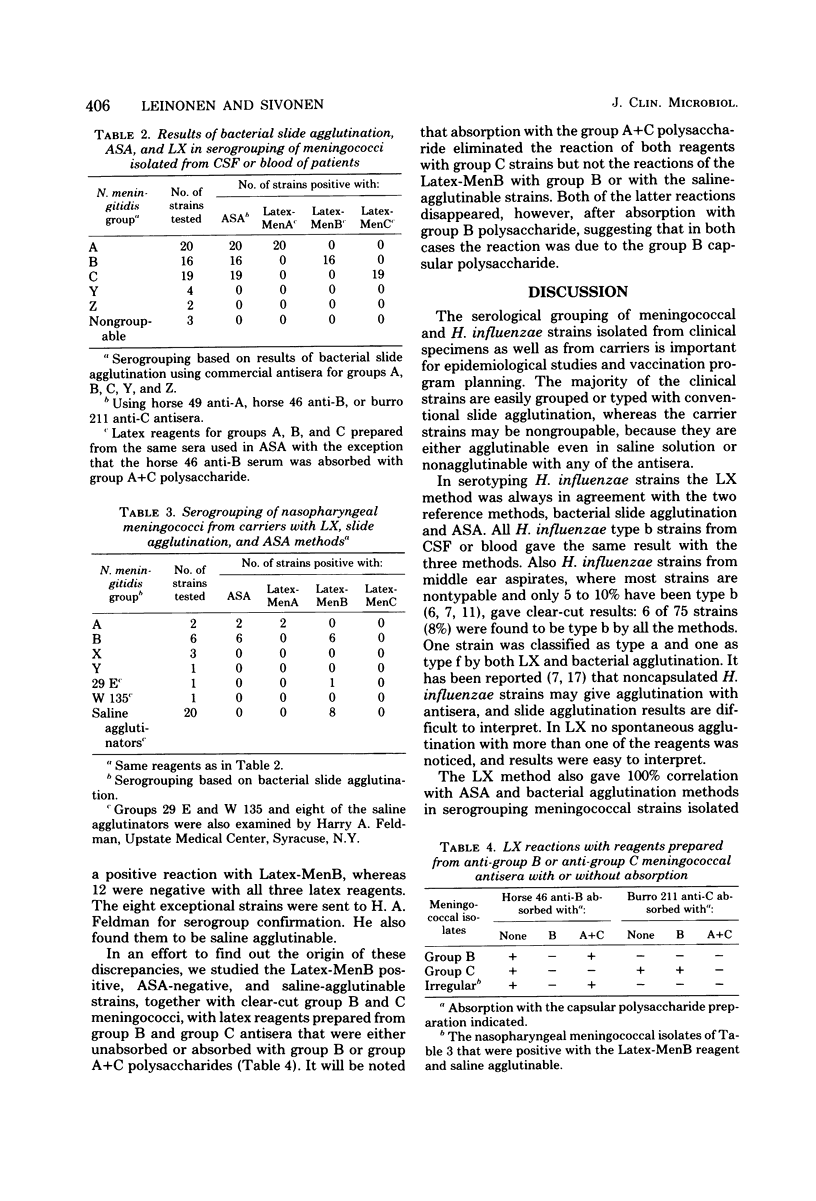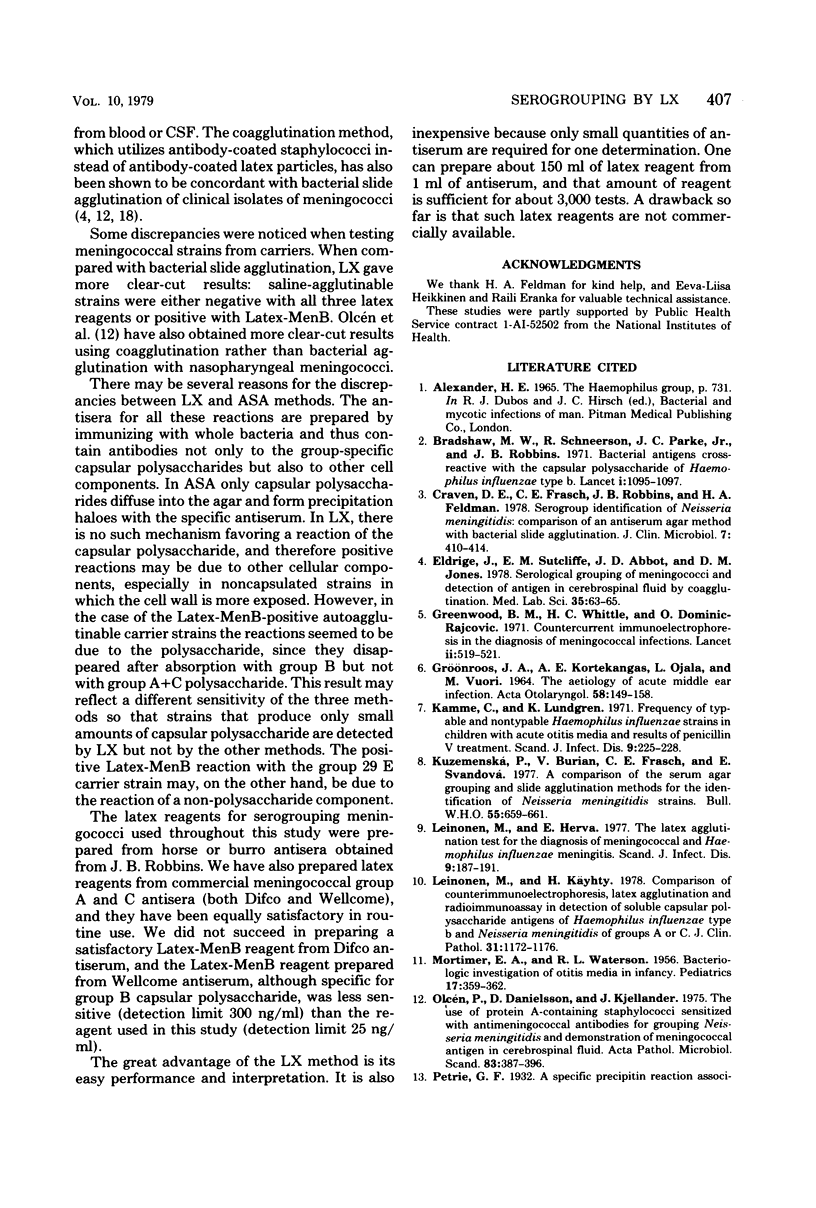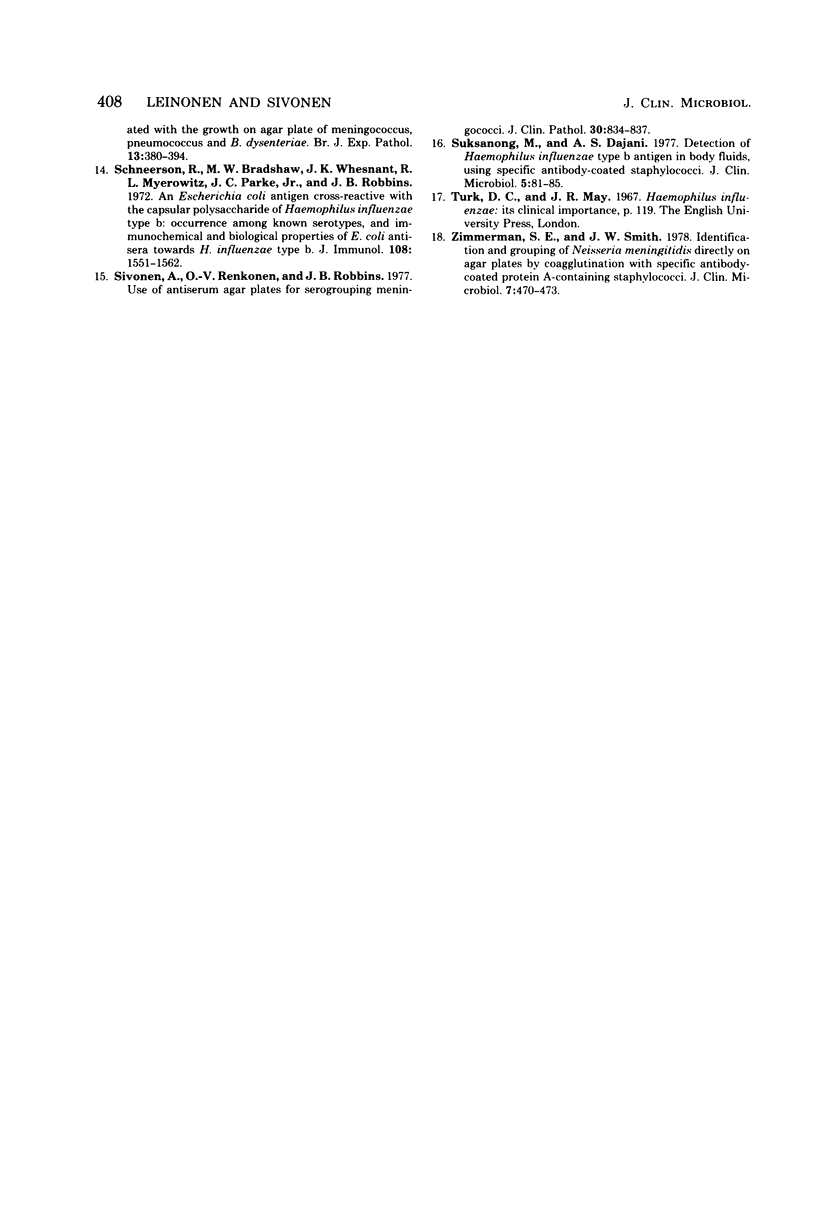Abstract
The latex agglutination method, utilizing antibody-coated latex particles, was adapted for serogrouping of Neisseria meningitidis and serotyping of encapsulated Haemophilus influenzae strains from agar plates. It was found to give more clear-cut results than conventional slide agglutination. A 100% agreement with the antiserum agar method was found for all strains isolated from blood or cerebrospinal fluid. Many meningococcal strains from nasopharyngeal carriers are autoagglutinable, but some of these gave a positive reaction with the group B latex reagent, although they were negative by the antiserum agar method. The latex agglutination method has several advantages over others: the lack of autoagglutination, easy performance, easy interpretation, and very low consumption of antisera.
Full text
PDF




Selected References
These references are in PubMed. This may not be the complete list of references from this article.
- Bradshaw M. W., Schneerson R., Parke J. C., Jr, Robbins J. B. Bacterial antigens cross-reactive with the capsular polysaccharide of Haemophilus influenzae type b. Lancet. 1971 May 29;1(7709):1095–1096. doi: 10.1016/s0140-6736(71)91837-x. [DOI] [PubMed] [Google Scholar]
- Craven D. E., Frasch C. E., Robbins J. B., Feldman H. A. Serogroup identification of Neisseria meningitidis: comparison of an antiserum agar method with bacterial slide agglutination. J Clin Microbiol. 1978 May;7(5):410–414. doi: 10.1128/jcm.7.5.410-414.1978. [DOI] [PMC free article] [PubMed] [Google Scholar]
- Eldridge J., Sutcliffe E. M., Abbott J. D., Jones D. M. Serological grouping of meningococci and detection of antigen in cerebrospinal fluid by coagglutination. Med Lab Sci. 1978 Jan;35(1):63–66. [PubMed] [Google Scholar]
- GROENROOS J. A., KORTEKANGAS A. E., OJALA L., VUORI M. THE AETIOLOGY OF ACUTE MIDDLE EAR INFECTION. Acta Otolaryngol. 1964 Aug-Sep;58:149–158. doi: 10.3109/00016486409121372. [DOI] [PubMed] [Google Scholar]
- Greenwood B. M., Whittle H. C., Dominic-Rajkovic O. Counter-current immunoelectrophoresis in the diagnosis of meningococcal infections. Lancet. 1971 Sep 4;2(7723):519–521. doi: 10.1016/s0140-6736(71)90439-9. [DOI] [PubMed] [Google Scholar]
- Kamme C., Lundgren K. Frequency of typable and non-typable Haemophilus influenzae strains in children with acute otitis media and results of penicillin V treatment. Scand J Infect Dis. 1971;3(3):225–228. doi: 10.3109/inf.1971.3.issue-3.08. [DOI] [PubMed] [Google Scholar]
- Kuzemenská P., Burian V., Frasch C. E., Svandová E. A comparison of the serum agar grouping and slide agglutination methods for the identification of Neisseria meningitidis strains. Bull World Health Organ. 1977;55(6):659–661. [PMC free article] [PubMed] [Google Scholar]
- Leinonen M., Herva E. The latex agglutination test for the diagnosis of meningococcal and haemophilus influenzae meningitis. Scand J Infect Dis. 1977;9(3):187–191. doi: 10.3109/inf.1977.9.issue-3.06. [DOI] [PubMed] [Google Scholar]
- Leinonen M., Käyhty H. Comparison of counter-current immunoelectrophoresis, latex agglutination, and radioimmunoassay in detection of soluble capsular polysaccharide antigens of Haemophilus influenzae type b and Neisseria meningitidis of groups A or C. J Clin Pathol. 1978 Dec;31(12):1172–1176. doi: 10.1136/jcp.31.12.1172. [DOI] [PMC free article] [PubMed] [Google Scholar]
- MORTIMER E. A., Jr, WATTERSON R. L., Jr A bacteriologic investigation of otitis media in infancy. Pediatrics. 1956 Mar;17(3):359–367. [PubMed] [Google Scholar]
- Olcén P., Danielsson D., Kjellander J. The use of protein A-containing staphylococci sensitized with anti-meningococcal antibodies for grouping Neisseria meningitidis and demonstration of meningococcal antigen in cerebrospinal fluid. Acta Pathol Microbiol Scand B. 1975 Aug;83(4):387–396. doi: 10.1111/j.1699-0463.1975.tb00117.x. [DOI] [PubMed] [Google Scholar]
- Schneerson R., Bradshaw M., Whisnant J. K., Myerowitz R. L., Parke J. C., Jr, Robbins J. B. An Escherichia coli antigen cross-reactive with the capsular polysaccharide of Haemophilus influenzae type b: occurrence among known serotypes, and immunochemical and biologic properties of E. coli antisera toward H. influenzae type b. J Immunol. 1972 Jun;108(6):1551–1562. [PubMed] [Google Scholar]
- Sivonen A., Renkonen O. V., Robbins J. B. Use of antiserum agar plates for serogrouping of meningococci. J Clin Pathol. 1977 Sep;30(9):834–837. doi: 10.1136/jcp.30.9.834. [DOI] [PMC free article] [PubMed] [Google Scholar]
- Suksanong M., Dajani A. S. Detection of Haemophilus influenzae type b antigens in body fluids, using specific antibody-coated staphylococci. J Clin Microbiol. 1977 Jan;5(1):81–85. doi: 10.1128/jcm.5.1.81-85.1977. [DOI] [PMC free article] [PubMed] [Google Scholar]
- Zimmerman S. E., Smith J. W. Identification and grouping of Neisseria meningitidis directly on agar plates by coagglutination with specific antibody-coated protein A-containing staphylococci. J Clin Microbiol. 1978 May;7(5):470–473. doi: 10.1128/jcm.7.5.470-473.1978. [DOI] [PMC free article] [PubMed] [Google Scholar]


